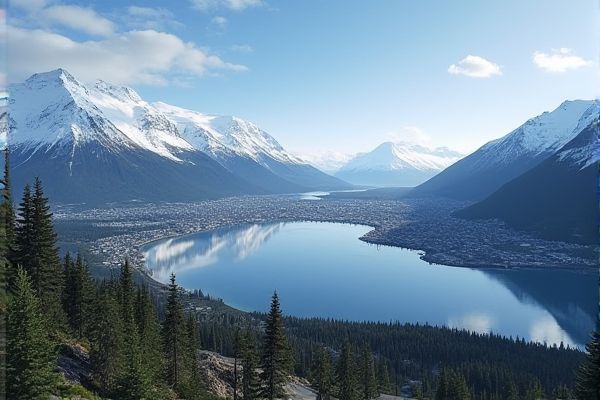
Education system and best schools in Alaska: Unique cultural and environmental integration. State-funded early education programs. Alaska Native cultural curriculum emphasis. Small student-to-teacher ratios. Distance learning options for remote areas. Focus on outdoor experiential learning. Top-ranked University of Alaska campuses. STEM program opportunities available. Emphasis on local community involvement. Specialized charter and magnet schools.
Unique cultural and environmental integration.
The education system in Alaska is evolving to integrate unique cultural and environmental aspects, with initiatives like the Alaska Native Knowledge Network promoting a symbiotic relationship between formal education and indigenous knowledge systems. Programs such as OLCG and MapTEACH incorporate local observations of climate change and hands-on geoscience experiences to preserve cultural integrity and environmental awareness.
State-funded early education programs.
Alaska does not have a statewide, state-funded pre-K program, but it has implemented various initiatives to support early education. The Alaska Reads Act, passed in May 2022, provides $3 million in competitive grants for school districts to develop or improve preschool programs, with a focus on meeting the Alaska Early Education Program Standards and enhancing school readiness for 4- and 5-year-old children.
Alaska Native cultural curriculum emphasis.
The Alaska Traditional Skills Curriculum focuses on integrating traditional Native Alaskan arts and subsistence skills into educational settings, particularly benefiting students with disabilities. This approach aims to strengthen their connection to local communities and nurture the development of work-related skills. Each unit of the curriculum is thoughtfully developed in collaboration with indigenous culture bearers and Elders. To learn more about how this unique educational strategy is being implemented, you can visit the Our Alaskan Schools website.
Small student-to-teacher ratios.
Alaska's education system offers several options that emphasize small student-to-teacher ratios, including charter schools, magnet schools, and microschools. For instance, charter schools like Knik Cultural School and magnet schools such as Barnette Magnet School often have smaller class sizes, and microschools, like The Green Room, focus on small-group learning and close-knit relationships. To learn more about these educational alternatives, you can explore the detailed guide on Alaska School Choice, which outlines various pathways available to parents and students seeking tailored academic experiences.
Distance learning options for remote areas.
In the vast and often remote regions of Alaska, educational opportunities transcend geographical barriers thanks to innovative platforms such as the Alaska Digital Academy. This institution provides high-quality, standards-based online courses designed for middle and high school students, offering enriched virtual instruction with access to certified teachers and adaptable learning schedules. Alongside this, K12-powered online private schools in Alaska offer tailored learning experiences that incorporate flexible class schedules, allowing students to progress at their own pace from anywhere with internet connectivity. Similarly, Prince William Sound College extends distance learning options, including online courses and an Associate of Arts degree, ensuring that education remains both flexible and affordable, all while maintaining small class sizes and round-the-clock technical support. These dedicated efforts collectively enhance the accessibility and quality of education throughout the state, enabling more students to pursue their academic goals regardless of their location.
Focus on outdoor experiential learning.
Alaska's outdoor experiential learning programs, such as the Outdoor School in Anchorage, offer immersive 2-day to 3-day programs for fifth graders, focusing on outdoor skills, science, history, and social-emotional learning. These programs collaborate with multiple state, local, and federal organizations to cultivate lifelong stewardship of public lands. For more information, visit the Outdoor School website.
Top-ranked University of Alaska campuses.
The University of Alaska system encompasses several top-ranked campuses, with the University of Alaska Fairbanks (UAF) standing out for its remarkable research opportunities, especially in climate change and Arctic studies, garnering global recognition for its research citations. Additionally, campuses like the University of Alaska Southeast (UAS) and the University of Alaska Anchorage (UAA) offer unique academic programs. For instance, UAS is renowned for its Sitka Whale Lab, while UAA provides specialized programs in aviation and Alaska Native Studies. For more information on these institutions, you can refer to the insights provided on the Best Colleges in Alaska blog.
STEM program opportunities available.
The Alaska Afterschool Network offers extensive STEM program opportunities, engaging students in hands-on, project-based learning, role modeling, and mentorship to foster interest in STEM fields. This initiative is supported by endeavors such as the Million Girls Moonshot, aiming to inspire the next generation of innovators. Similarly, Campbell STEM, a PreK-6th grade public school in Anchorage, AK, provides a rigorous interdisciplinary STEM curriculum that integrates hands-on inquiry, the engineering design process, and real-world problem-solving with community and business collaborations. Additionally, the Alaska Native Science & Engineering Program (ANSEP) offers year-round opportunities, including free summer programs for students from middle school to doctoral levels, supported by hands-on activities, internships, and career development through various academies and partnerships.
Emphasis on local community involvement.
The education system in Rural Alaska emphasizes local community involvement through initiatives like Alaska Onward to Excellence (AOTE), which fosters school-community partnerships, integrates indigenous knowledge, and promotes shared decision-making and cultural integration to improve educational outcomes for Alaska Native students. For more detailed information on this initiative and its impact, you can access the Alaska Onward to Excellence resource.
Specialized charter and magnet schools.
Alaska offers specialized education through charter and magnet schools. Charter schools, which serve over 7,000 students, are public schools that manage their own operations and often focus on specific community needs, such as the Knik Cultural School emphasizing Alaska Native culture. Magnet schools, attended by 12.2% of K-12 students, provide focused learning tracks like engineering or the performing arts, such as the Barnette Magnet School in Fairbanks. For more details on these educational options, visit the Alaska School Choice website to explore the diverse opportunities available to students in the state.
